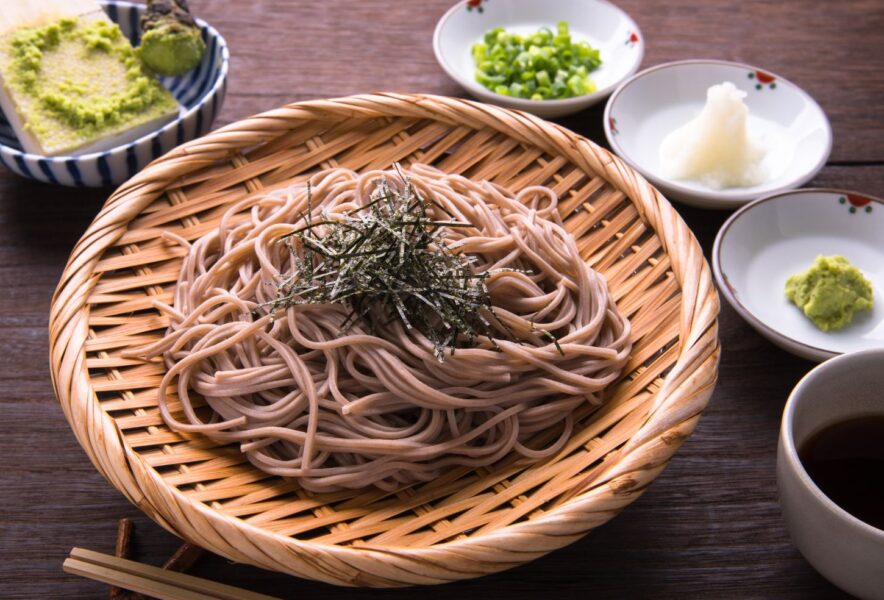Soba, Japan’s beloved buckwheat noodle, has been a staple of the country’s cuisine for centuries. In Tokyo, where tradition meets innovation, soba continues to be a favorite for its simplicity, health benefits, and versatility. One of the unique aspects of soba is that it can be enjoyed both hot and cold, offering a delightful experience no matter the season. Whether you’re craving a hot, hearty bowl of soba in winter or a refreshing cold dish in summer, Tokyo has countless options to explore. As someone who spends time crafting detailed bento boxes, I appreciate how a simple dish like soba can offer such variety. Let’s dive into the rich history of soba, its different types, and the best places to enjoy it like a local.
The History of Soba: A Culinary Legacy
Soba’s roots go back to the Edo period (1603–1868), when it became a popular fast food for the working class in Edo (modern-day Tokyo). Buckwheat, the main ingredient in soba, grows well in Japan’s mountainous regions, making soba a widely accessible food. It was quick to make, nutritious, and affordable, which made it a staple for busy city dwellers.
One of the long-standing customs associated with soba is toshikoshi soba, traditionally eaten on New Year’s Eve. The long noodles symbolize longevity, making it a dish that signifies good fortune for the year ahead. Soba’s role in Japanese culture highlights its deep connection with both everyday life and special occasions.
Different Types of Soba: Hot and Cold
As someone who enjoys variety, I love that soba can be served hot or cold, with endless possibilities for toppings and broths. Here are some of the most popular types of soba:
- Kake Soba: This simple dish features soba noodles served in a light, clear broth made from dashi, soy sauce, and mirin. It’s a comforting dish that focuses on the delicate flavor of the noodles.
- Tempura Soba: For a more indulgent experience, tempura soba includes crispy tempura (usually shrimp or vegetables) served atop soba in a hot broth. The contrast between the crunchy tempura and soft noodles is a must-try for anyone new to soba.
- Zaru Soba: Zaru soba is served cold on a bamboo tray, with a dipping sauce made from soy sauce, dashi, and mirin. As someone who enjoys cold dishes in the summer, this refreshing version is perfect for beating the heat.
- Tororo Soba: Topped with grated yam (tororo), this version adds a unique, smooth texture to the dish. While the texture may be surprising at first, it’s satisfying and pairs well with the light sauce or cold noodles.
- Kitsune Soba: Featuring sweet, fried tofu (aburaage), this soba version offers a balance of savory and sweet flavors. The tofu’s sweetness contrasts nicely with the earthy taste of the soba noodles.
Each variety has its own distinct character, and as someone who loves to experiment with food combinations, I appreciate how soba can be adapted to suit different seasons and preferences.
The Evolution of Soba: Tradition Meets Modernity
While traditional soba is still widely enjoyed, Tokyo’s vibrant food scene has embraced new interpretations of this classic dish. You’ll find restaurants serving modern takes on soba, with creative toppings and flavors that cater to contemporary tastes. As someone who enjoys the mix of old and new in food, it’s exciting to see soba served in innovative ways.
For example, some restaurants now offer soba salads or fusion-style soba with creamy sauces or Western-inspired broths. These modern versions show how soba continues to evolve, reflecting Tokyo’s dynamic food culture. Yet, even with these updates, the essence of soba remains the same—a simple, satisfying dish rooted in tradition.
Where Locals Eat Soba: Top Soba Chains in Tokyo
When it comes to grabbing a quick and delicious bowl of soba, many locals in Tokyo turn to popular soba chains. These spots offer affordable, reliable options for those in a hurry or on a budget, without sacrificing quality. Here are two of the best chains where you can enjoy authentic soba like a local:
- Fuji Soba
With locations across Tokyo, Fuji Soba is a convenient option for anyone looking to enjoy a quick bowl of soba. The menu includes both hot and cold soba dishes, and you can customize your meal with toppings like tempura, egg, or seaweed. Known for its fast service and reasonable prices, Fuji Soba is a favorite among busy Tokyoites, and it’s a great place for travelers to experience a typical Tokyo lunch.
Fuji Soba Official Website - Komoro Soba
Another popular chain, Komoro Soba offers freshly made soba at an affordable price, making it a go-to for locals and visitors alike. The menu includes traditional dishes like kake soba and zaru soba, with seasonal options that highlight Japan’s fresh ingredients. With several locations around the city, Komoro Soba is a great spot to enjoy a simple yet delicious bowl of soba.
Komoro Soba Official Website (Japanese)
These chains are perfect for anyone looking to experience authentic soba without spending a lot of time or money, offering a glimpse into the everyday dining culture of Tokyo.
Conclusion: Savor the Best Soba in Tokyo
Soba is more than just a meal—it’s a connection to Japan’s history and culture. Whether you’re enjoying a comforting bowl of kake soba in the winter or indulging in refreshing zaru soba on a hot day, Tokyo’s soba scene offers something for everyone. As someone who loves simple yet flavorful food, I highly recommend trying both the traditional and modern takes on this classic dish. Don’t miss the chance to savor soba during your time in Tokyo, whether you stop by a local favorite like Fuji Soba or explore the flavors at Komoro Soba.

Comment